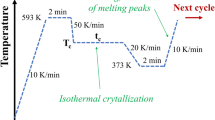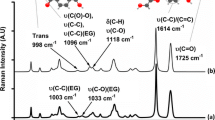Abstract
Differential thermal analysis (DTA), high pressure differential thermal analysis (HP-DTA), and high temperature X-ray studies are combined to elucidate the origin of the two melting peaks in Nylon-11. The results of the studies suggest that two species of crystals are involved in the melting of Nylon-11 for samples crystallized at atmospheric pressure or when the environmental pressure is below 4 kbar. At atmospheric pressure, the high melting species is predominant. However, under hydrostatic pressures, the high melting species undergoes phase transition to the low melting species before melting. The amount of the material involved in the transition depends on the pressure. At pressures of 4 kbar or greater, the entire high melting species transforms to the low melting species. The melting behaviour, at atmospheric pressure, of samples crystallized at high pressures also shows two melting peaks if the crystallization pressure is below 4 kbar. The amount of the low melting species increases with increasing pressure and, at 4 kbar or higher, only melting of the low melting species is observed. The X-ray photographs taken at room temperature suggest that samples crystallized between atmospheric pressure and 3 kbar contain both theα-form and theδ′-form crystals but the samples crystallized at 4 kbar and higher contain only theα-form crystal. However, it appears from X-ray scans taken at high temperatures near melting that the low melting species is of theδ-form and the high melting species of the δ′-form crystals for samples crystallized below 4 kbar. Theδ-form crystals result from theα-δ transition that occurs at 95° C. Moreover, the melting at high pressures (<4 kbar) of samples crystallized at atmospheric pressure also appears to involve aδ′-δ transition. These results suggest that both the crystal forms,δ andδ′, are stable at high temperatures, if the environmental pressure is below 4 kbar, and that only theδ-form crystals are stable up to melting at pressures greater than 4 kbar.
Similar content being viewed by others
References
S. Gogolewski andA. J. Pennings,Polymer 18 (1977) 660.
T. R. White,Nature 175 (1955) 895.
G. Guarato, A. Fichera, F. Z. Grandi, R. Zannetti andP. Canal,Die Makro Chemie 175 (1974) 953.
G. F. Schmidt andH. Z. Stuart,Z. Naturgorsh (A) 13 (1958) 222.
W. P. Slichter,J. Polymer Sci. 36 (1959) 259.
A. G. Last,ibid. 39 (1959) 543.
K. Little andD. Br. Phil,J. Appl. Phys. 10 (1959) 255.
T. Sassk,Polymer Lett. 3 (1965) 557.
D. P. Hummell, “Atlas der Kunststoff — Analyse”, Band I (Carl Hanser Verlag, Munchen, 1968).
B. A. Newman, T. P. Sham andK. D. Pae,J. Appl. Phys. 48 (1977) 4092.
J. Scheinbeim, C. Nakafuku, B. A. Newman andK. D. Pae,ibid. 50 (1979) 4399.
Author information
Authors and Affiliations
Rights and permissions
About this article
Cite this article
Chen, P.K., Newman, B.A., Scheinbeim, J.I. et al. High pressure melting and crystallization of Nylon-11. J Mater Sci 20, 1753–1762 (1985). https://doi.org/10.1007/BF00555281
Received:
Accepted:
Issue Date:
DOI: https://doi.org/10.1007/BF00555281




